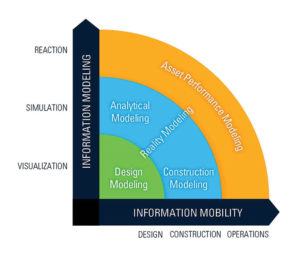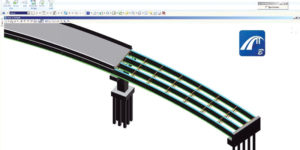Design, modeling, and analysis are keys to the success of today’s bridge projects. The next generation of bridge modeling software requires that the model is purpose-built for bridge designers and contractors who need to create, construct, maintain, and document a wide variety of bridge information throughout the lifecycle of the bridge. Sharing information in an information-rich 3D model increases data quality, collaboration, constructability, and operational aspects including asset management. Reduction in the project’s overall costs for the entire system are important for all stakeholders, and the availability of intelligent 3D models are an essential component in providing accelerated project delivery and information mobility.

Figure 1. The availability of intelligent 3D models is a key component in providing accelerated project delivery and information mobility.
Information Modeling
In just a matter of a few years, the bridge industry has shifted focus to hone the definition of intelligent 3-D models. What does it mean to provide an intelligent and data-rich 3D model that connects design, construction, inspection, operations, and maintenance? How much is too much information and what is our goal? Can we shorten the construction schedule? Are we designing for construction and can we meet the expectations of the traveling public during construction with the proposed design? A true data model addresses these questions and increases the integrity of our engineering profession. For example, the owner/designer and contractor could be involved in the development of a model in the earliest stages, and they can address constructability issues before construction begins to ensure that the project stays on course, on schedule, and on budget. Evaluating construction phasing ahead of time eliminates conflicts during construction. An intelligent, data-rich model is more than a visualization of a conceptual design. It provides valuable insight into the future of a project, making the outcome more predictable. Vision meets reality with the creation of an information-rich data model that can be used throughout the life of the bridge.
Build It Better Trends – Driven to Innovate
Engineers, detailers, and contractors are under increased pressure to find the solution that promotes better designs resulting in smarter and more reliable construction methods. A disconnect between project and stakeholders is no longer acceptable in our industry and is driving the need for data interoperability throughout the lifecycle of the bridge.
Pretty picture models do not lead to reality when constructability is at stake. The days of bidding on infrastructure projects have evolved into the owner-operator setting higher expectations for minimizing allowances, omissions, and errors as added risks on the project.
This has led to a situation where the market demands better methods for reducing construction costs and minimizing economic impacts. The MAP-21 compliance requirements, Every Day Counts (EDC) legislation, and the growing popularity of design-build and Public Private Partnerships (P3) has set the stage for bridge project delivery expectations.
These initiatives on design/construct/rehabilitate contracts are driving the owner demand for faster, more cost-effective and constructible means of building our transportation assets.

Figure 2. OpenBridge Modeler is purpose-built for bridge designers and contractors who need to create, visualize, analyze, construct, maintain, and document a wide variety of bridge information throughout the lifecycle of the asset.
Traditional Bridge Design Process
Unfortunately, the bridge design and construction workflow is often a fragmented and linear process with very little automation or exchange of data in a useful or integrated manner. The ability to reuse data across disciplines is challenging and creates an environment prone to data re-input among multiple programs and spreadsheets as a byproduct – resulting in the introduction of error-prone results.
These processes traditionally involve centralized automation (roadway does roadway, bridge does bridge, inspectors do inspection) and there is a minimal exchange of critical project and engineering data between the primary disciplines.
Imagine a typical scenario of designing a facility over another new or existing facility and all of the conflicts and challenges this presents. The instantaneous access and ability to tweak pier placement as you evaluate existing conditions is critical in these situations and common in design-build projects. Typically, geometric information transferred from the roadway design team is an inefficient manual and repetitive data entry process. There is no time to waste when alignments require shifting to keep a project moving. With errors, re-dos, model translations, multiple spreadsheets, and shortened delivery timeframes, communication often breaks down while working under tight deadlines. This causes data to be dropped and, in most cases, it is not reused.
Dealing with broken lines of communication among teams and error-prone workflows, or just dealing with multiple software products from different vendors, can exacerbate the disjointed design process. Lastly, but certainly one of the more important in traditional project delivery, is plan production. Often, this is not an automated process or at least not one that is efficient or automated in a manner to which stakeholders are accustom.
There are tremendous advantages in connecting project team members with a 3D approach and 3D technology.
An Intelligent Data Process
The benefits of having a geometry that is relevant and current will tie roadway and bridge engineers together from the onset of the project, and throughout design revisions, in a bi-directional manner. Not only are they working in a connected manner, but they are also working geospatially for improved accuracy.
Bridges can be developed and modeled in a real-world environment. Referencing existing conditions becomes easy and meaningful. Models become the immediate mechanism for design and analytics. Imagine the time and cost savings of efficiently developing an intelligent model in the preliminary stages of a project – and carrying this through to design and analysis without requiring the time or expense of re-engineering. Currently, most modeling technology does not allow for a direct link to analytics without some re-entry of data; nor do these models contain the level of detail required for today’s projects.
The ability to link the physical model directly to the analytics allows for alternate design options to be realized initially, in the office, as you are saving time and effort by reviewing alternatives, constructability issues, and conflicts in the earliest development of the bridge. Much of the design is for construction of course, but at what point do we begin to insert intelligence into the design so that we can predict and plan for construction? When does the design take into account construction steps? Today, that is usually a post-design process, where the design is passed to a construction engineering team, who dissects the design and reassembles it into construction plans.
With the massive amount of intelligence available between disciplines, it is only logical to collaborate and leverage it in a seamless workflow. Tools are available to make intelligent bridge design and analysis a reality. These tools will speed construction with little effort on the front end.
An efficient bridge design process allows you to directly connect and reference existing and proposed conditions, as well as civil data to perform constructability analysis – key to the maintenance of traffic – and for the facility over facility situations. By allowing the designer to visualize, render, perform clash detection, generate quantities, and evaluate clearances with the information-rich model, you can be assured of reliable construction methods from the onset.
Bridge modeling technology should provide engineers with the ability to create a workflow that promotes accurate information modeling and mobility. There needs to be an interoperability component that allows all project disciplines to evaluate and share critical data from the planning/bidding phases all the way through to commissioning, operations, and maintenance. The real value of a model doesn’t solely reside in its aesthetic appeal, but also in the usability and life of the data associated with it.
OpenBridge Modeler by Bentley is one software package that addresses the challenges that design teams and contractors face with complex geometry needs, parametric updating of changes, and evaluating constructability early in the process, including conflicts not seen in a 2D workflow. Software like OpenBridge Modeler enables the user to work on a bridge project, share engineering-rich data, and make more informed decisions within a 3D model, thus accelerating construction.
All disciplines (roadway, utilities, bridges, existing conditions, and so on) operating in a single modeling environment with no re-creation of critical project data is vital in meeting the challenges of a 3D deliverable by industry standards. Such models facilitate collaboration and integration with other disciplines to ensure everyone has the data they need when they need it.
3D bridge models provide the ability to reference related designs that connect or affect the project. Subsurface utilities, rebar detailing, bridge element placement, and traffic maintenance are all key construction issues that, in an integrated and interoperable workflow, can be detected and resolved in the office rather than in the field. This ability enables you to meet the owner’s expectations for minimizing omissions and errors.
Summary
With a focus on operational excellence, sustainability, and the economic impacts of a bridge not being available, it has never been more important to evaluate our processes. Bridge design and construction processes are evolving, and 3D deliverables are imminent.
Interoperability and collaboration are keys to the success of bridge projects of all sizes and construction methods. Leveraging complex geometry from the beginning to generate physical bridge models, and preparing the design and analytical requirements, is essential to moving to a more fluid and seamless reality modeling workflow. With intelligent as-designed models and as-built data, engineers can provide operations and maintenance value for the entire life of the bridge.▪
